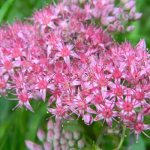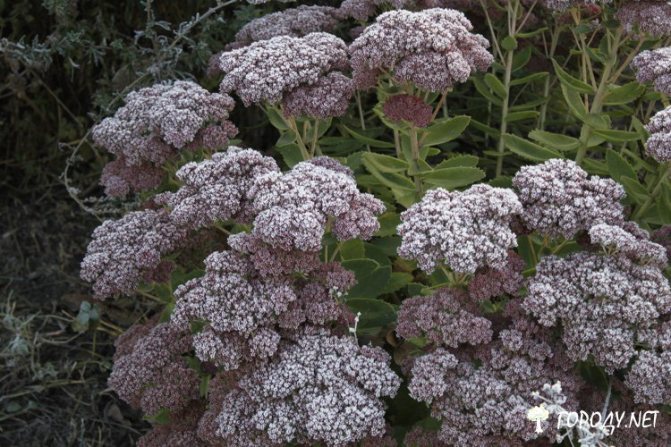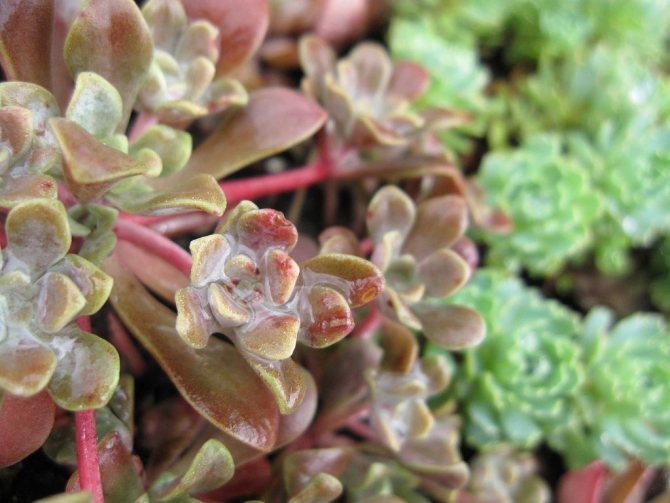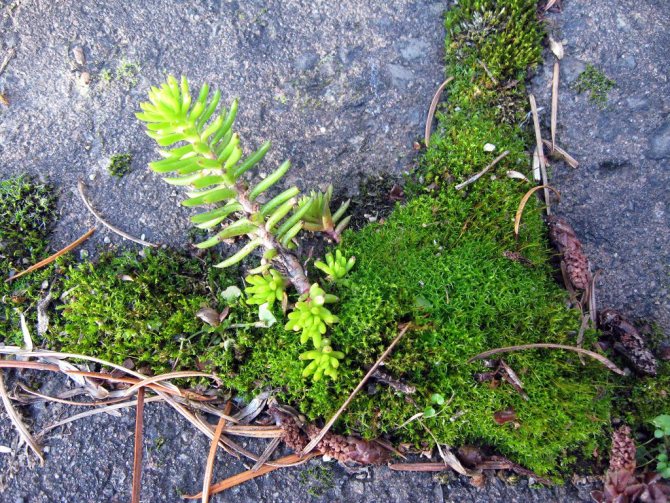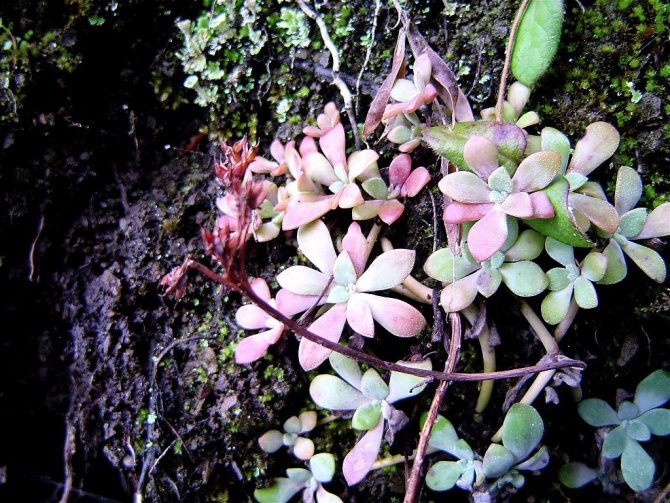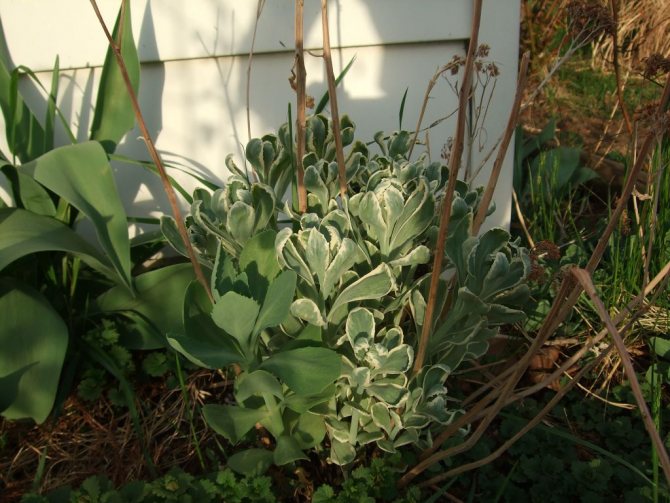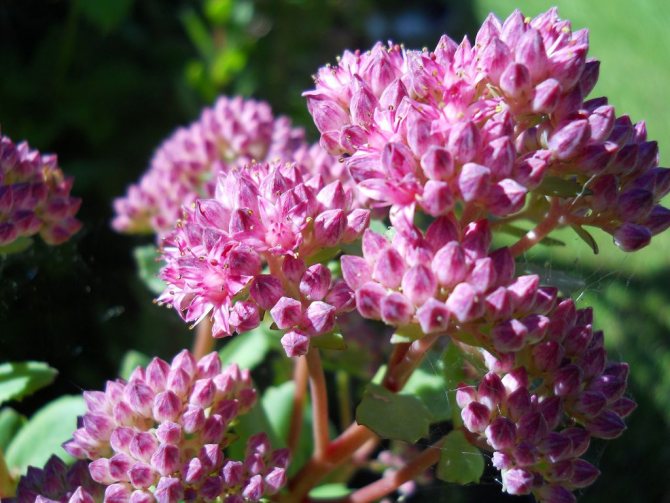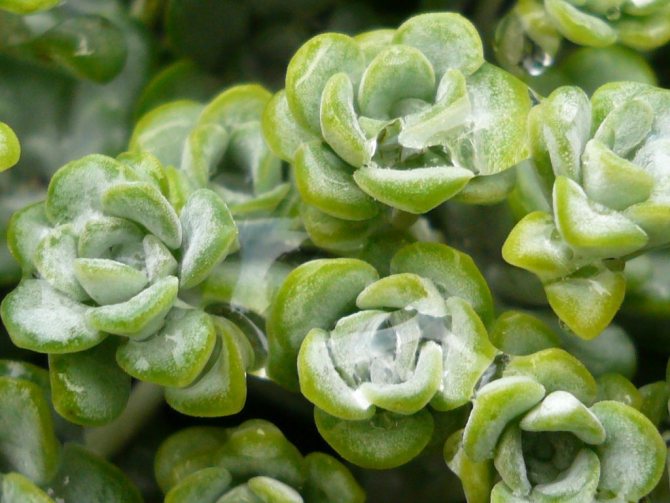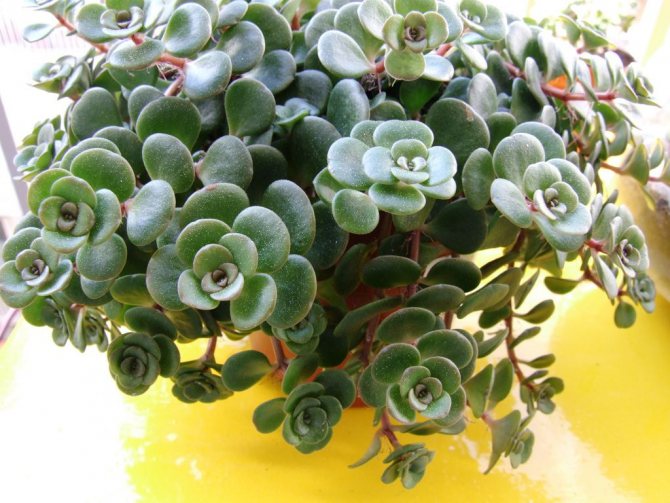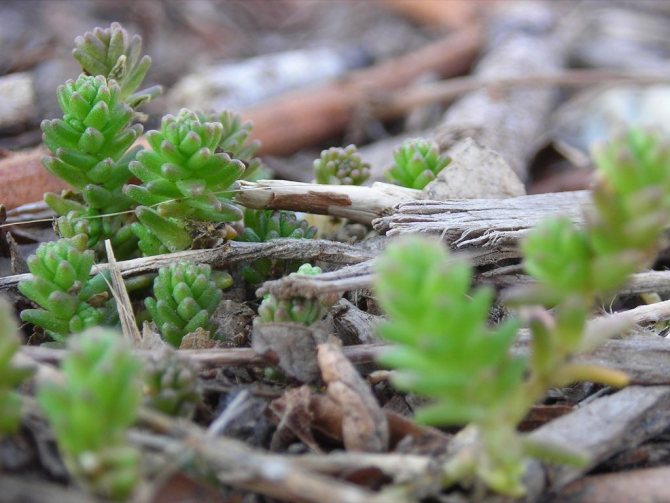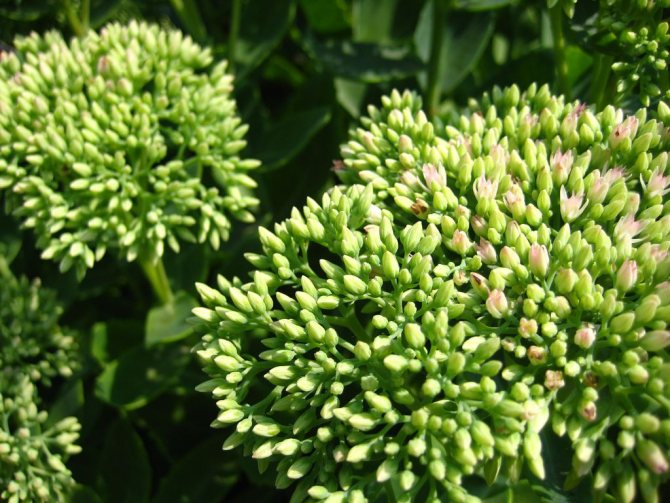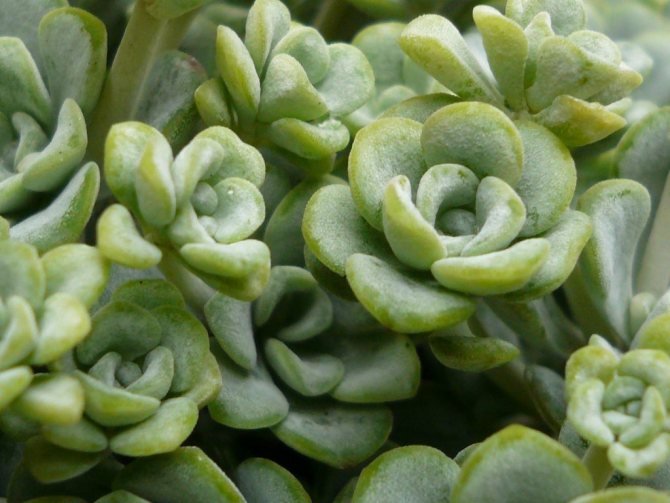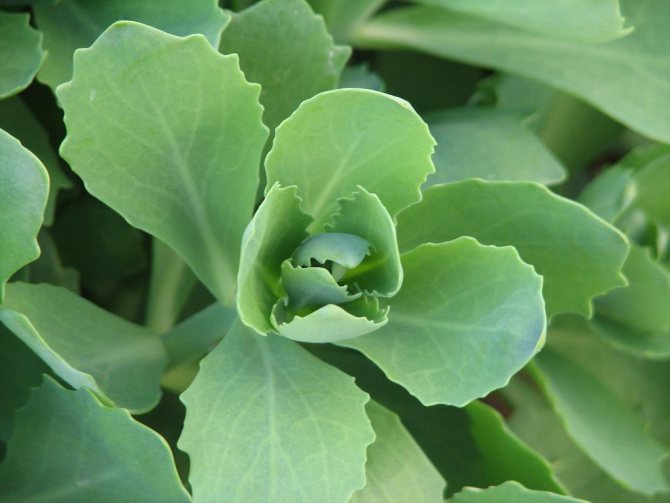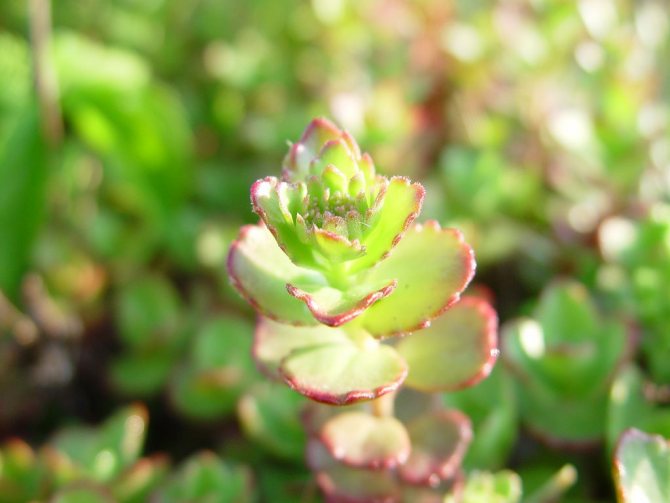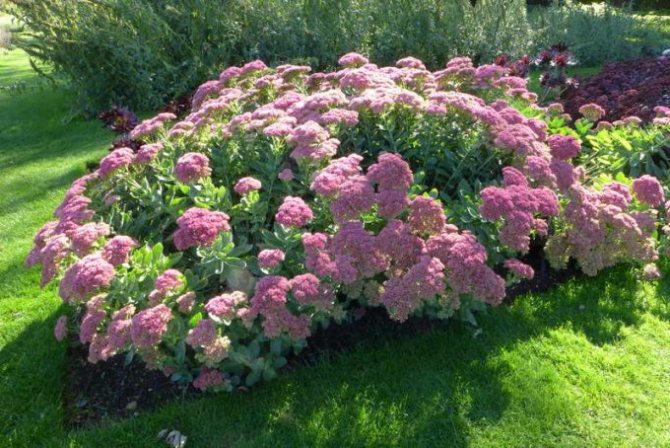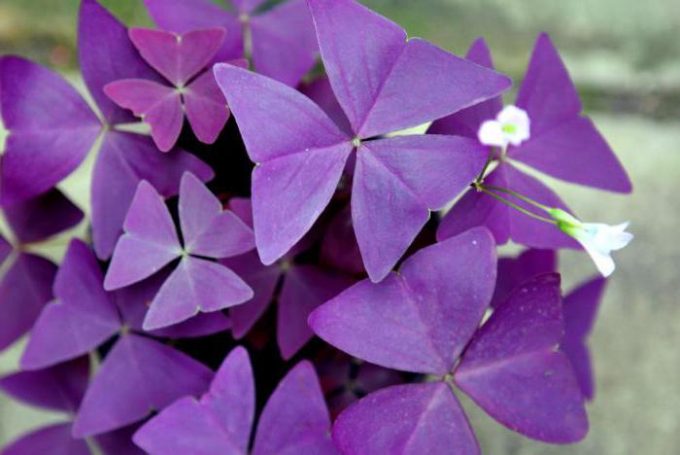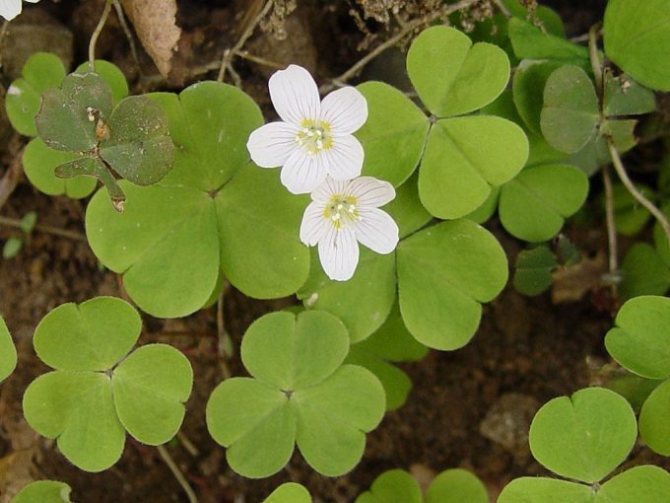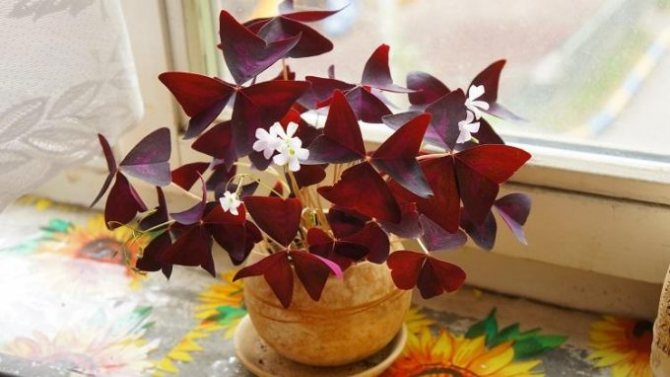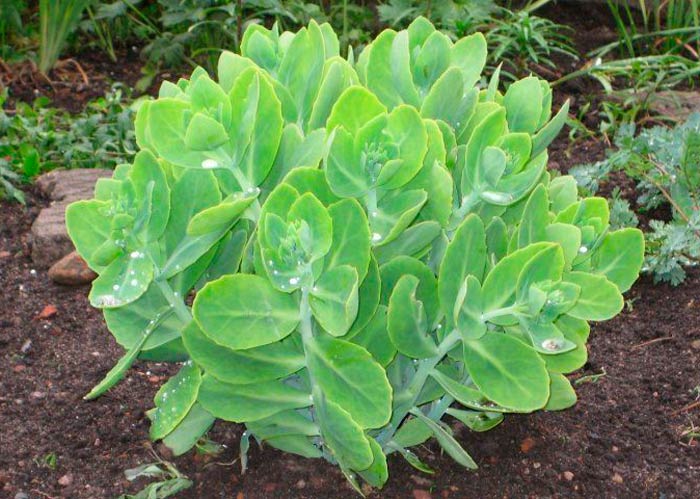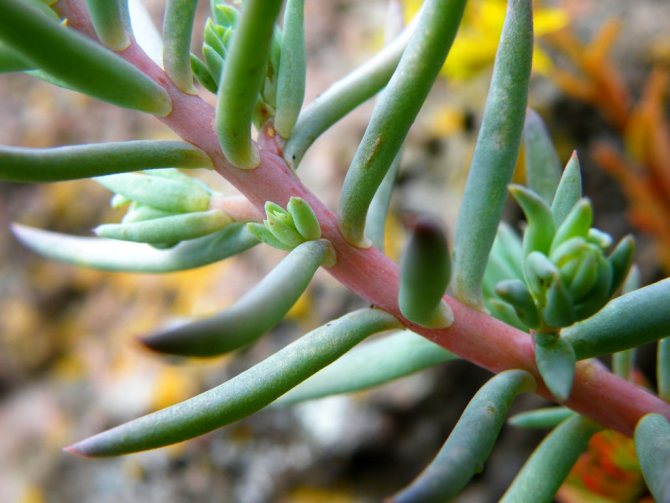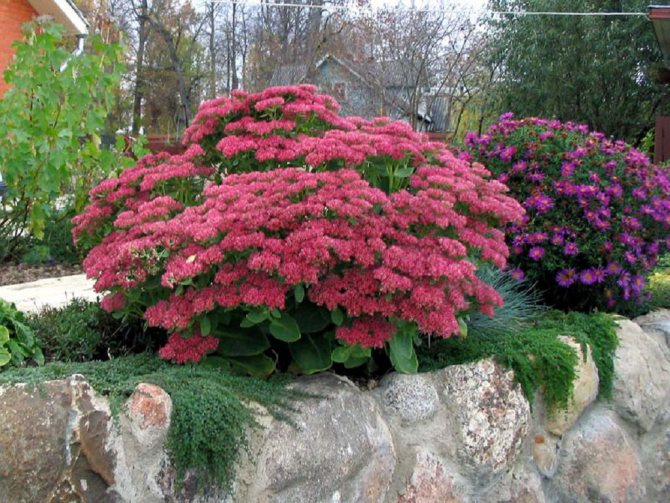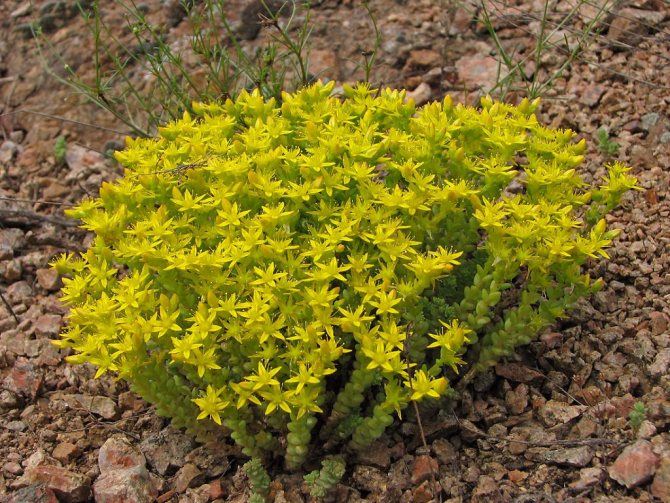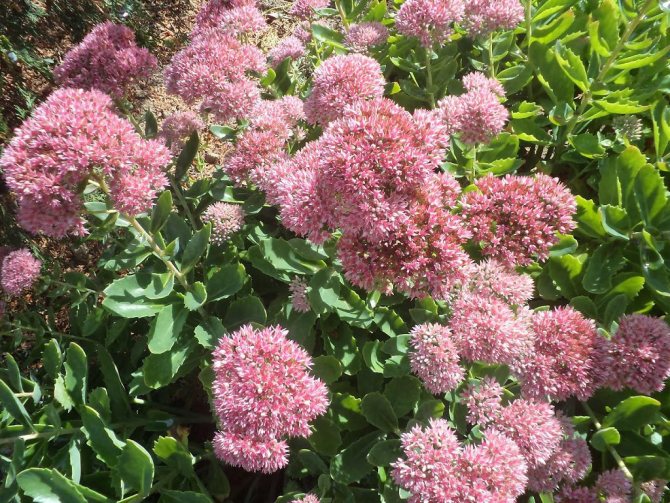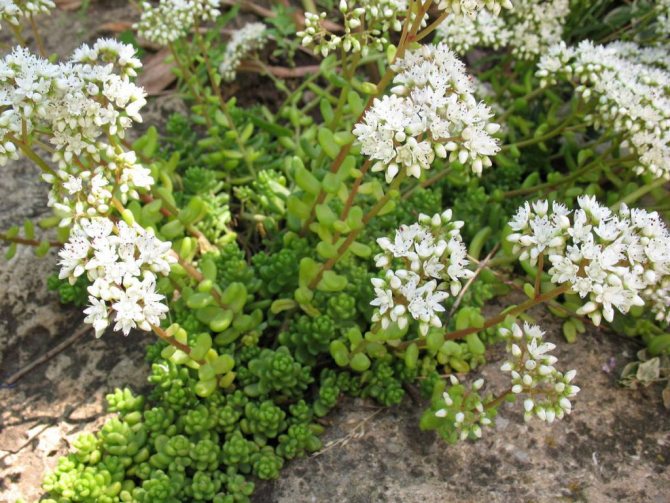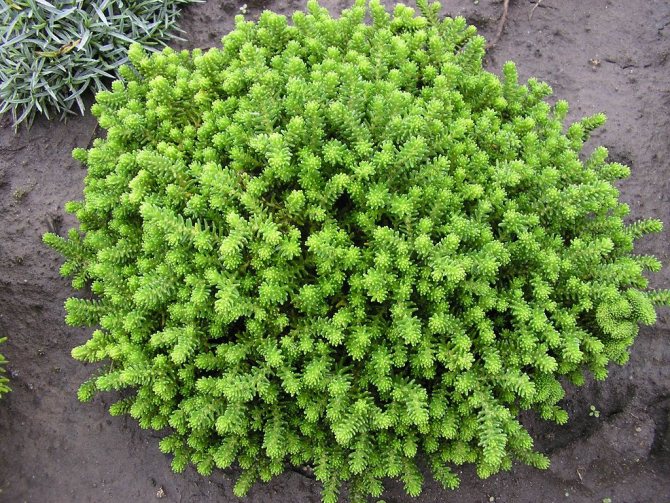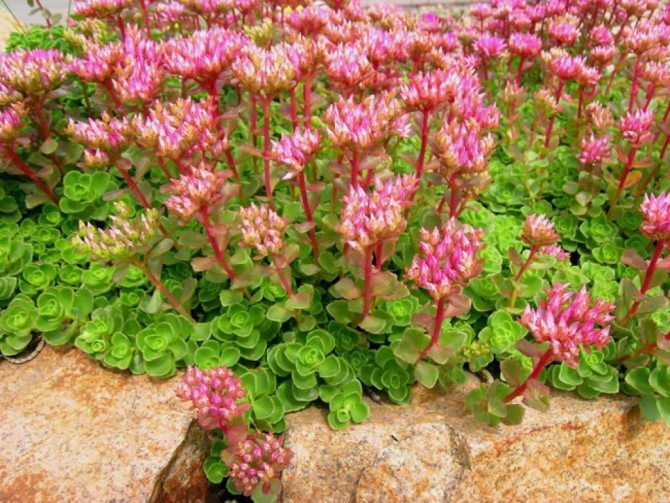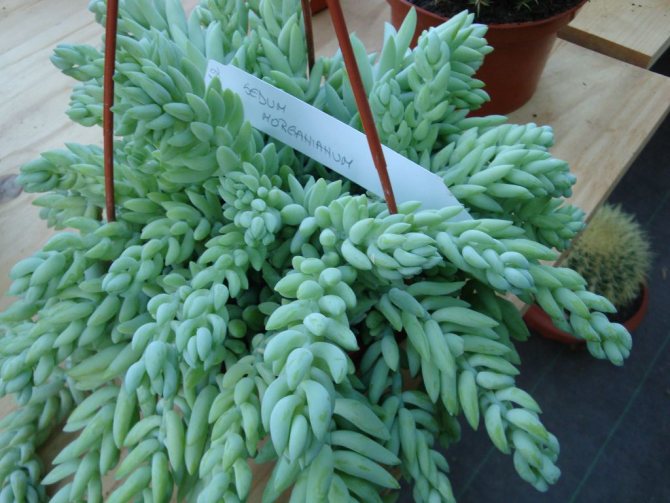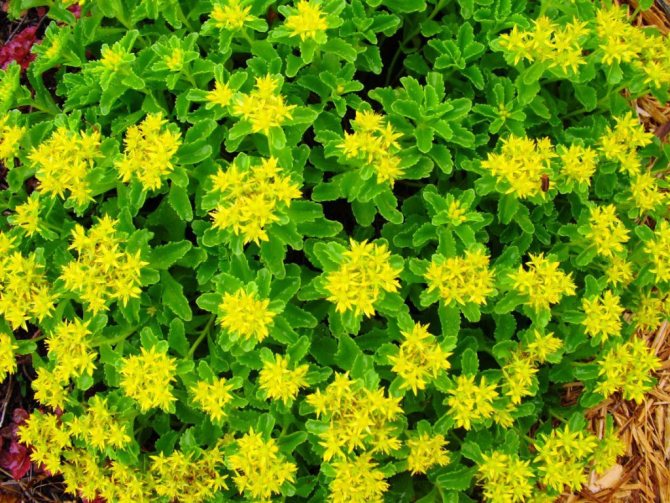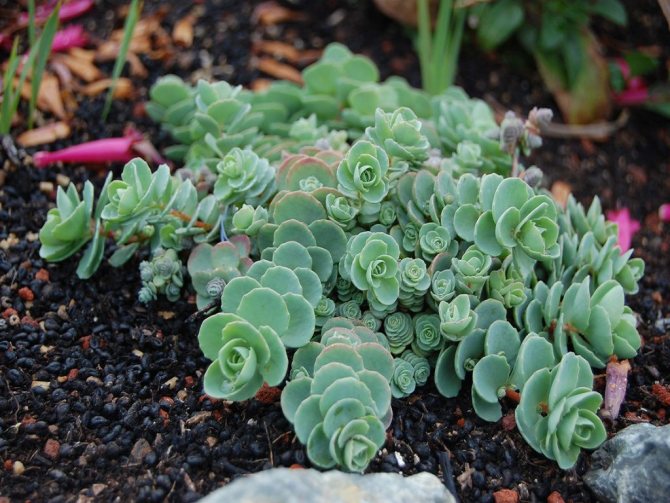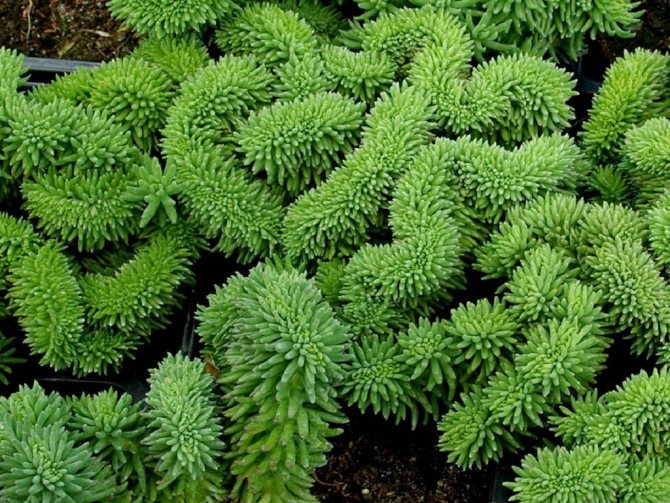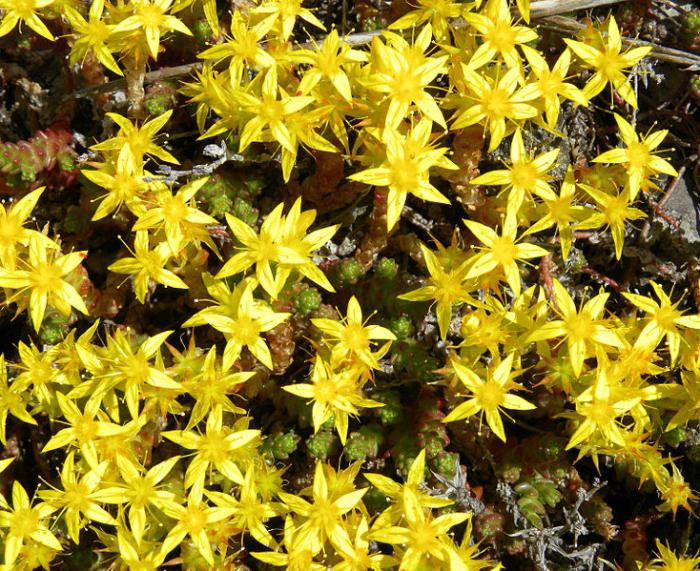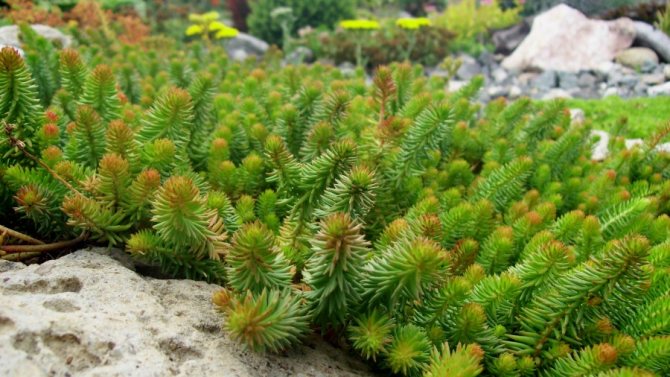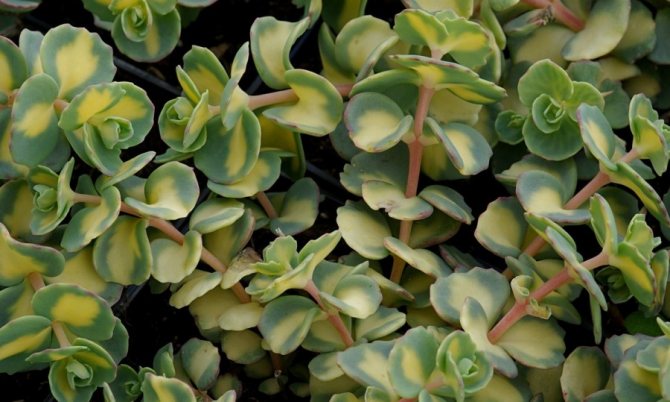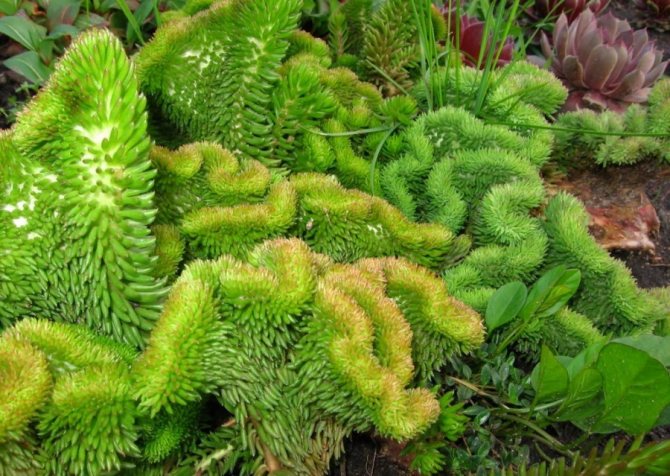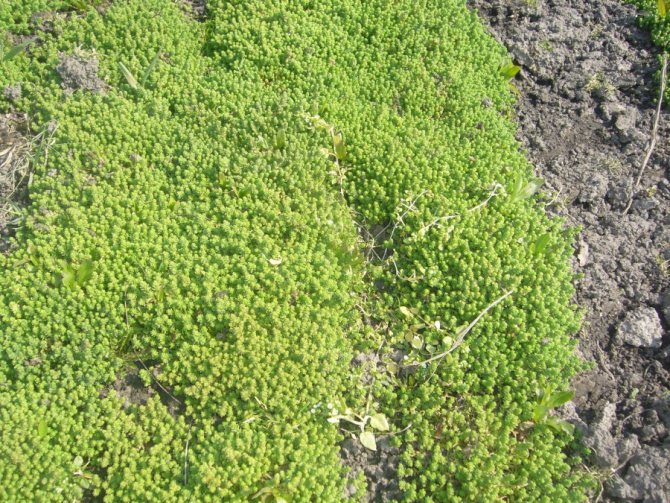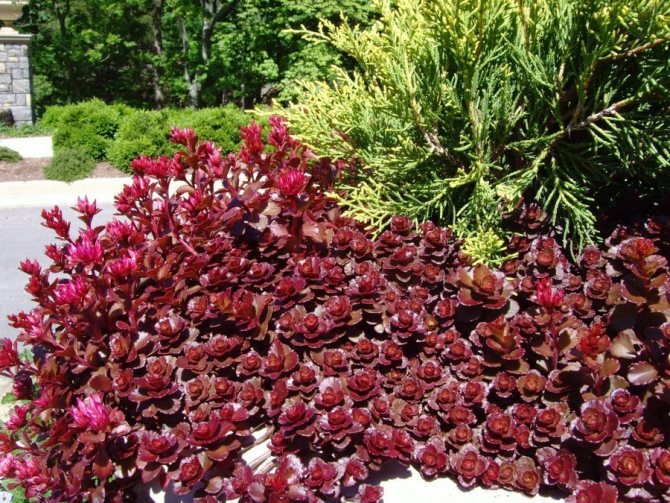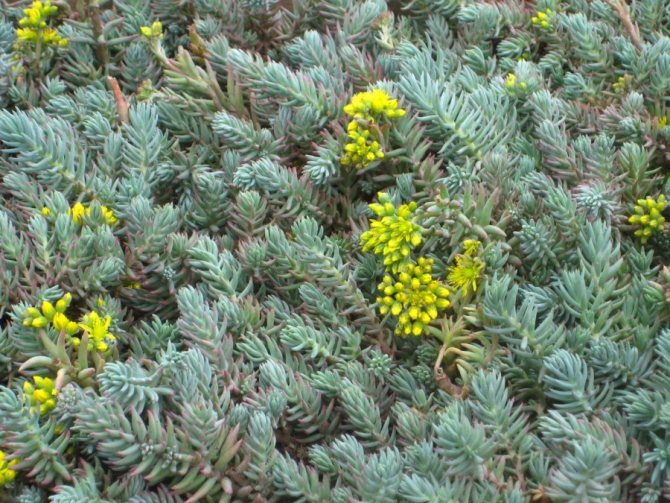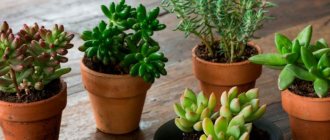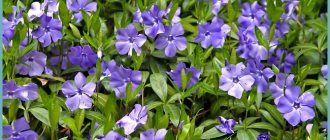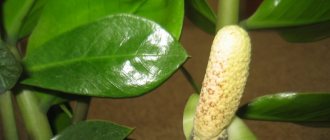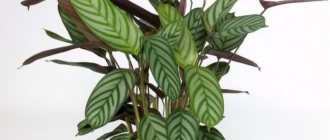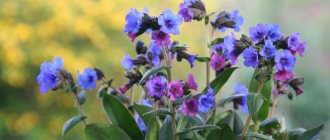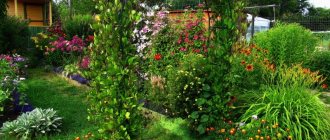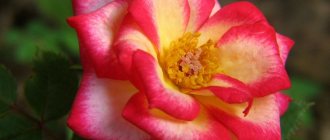Description of the plant
Sedum, as the purple sedum is otherwise called, is a member of the Tolstyankov family. By the type of development, the plant belongs to succulents and has more than 500 speciesgrowing both in cold northern climates and in the tropics.
External signs of sedum:
- Erect fleshy stem without branches. Based on a fibrous root system, the plant does not grow deep into the soil. The height of the upper part depends on the habitat and varies from 15 to 65 cm. In the winter, sedum stems die off to start living again in the spring.
- The leaves, like many succulents, are fleshy and juicy. They are oval-oblong in shape, the length can vary from 1.5 to 8 cm.
- Flowers form small inflorescences (3–8 cm), they have no upper leaves. One cup contains 5 green petals surrounded by a corolla of 5 purple petals. The flowering time of the plant is from the end of July to the end of September.
- After flowering on stonecrop, fruits with seeds are formed.
Sedum purple (see photo) has many popular names: squeaky grass, rejuvenated, hare cabbage, hernial grass... Likes to settle on the slopes of the mountains, along the banks of rivers and lakes, on the roadsides and in the fields.
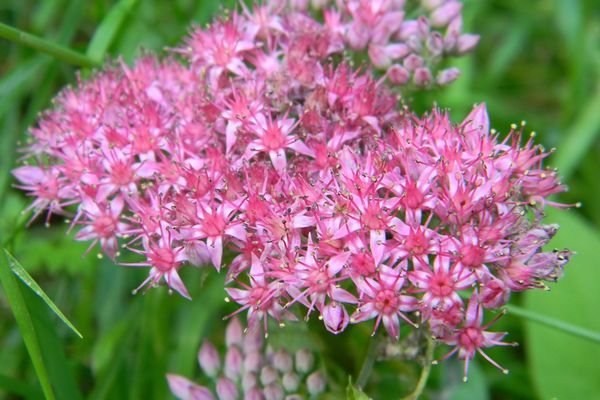
How else is sedum used?
The plant is actively used in veterinary medicine in the treatment of disorders of the digestive system in cattle.
Hare cabbage is a wonderful honey plant. When a drought hits, it releases a huge amount of nectar, attracting bees from all over the area. The honey is very aromatic, golden yellow. It belongs to the elite varieties used for medicinal purposes.
In addition, the plant is also used as a decorative plant in summer cottages. With its help, they create a continuous vegetative green carpet, they cover the rocky, sandy, bare areas of the garden.
Growing and planting rules
Occupying all sorts of areas of the earthen space, sedum manages to grow and develop on soils with any composition.
However, the optimal type of soil for a plant is sandy loam with a drainage layer. When growing hare cabbage in a garden plot, a succulent is transplanted as follows:
- An adult plant is buried so that it can be pulled out without damaging the root system.
- The day before planting the separated plant, the soil in the new place is treated with a solution of potassium permanganate.
- Then a pit is made 20–25 cm deep. A drainage layer is poured onto the bottom of the pit and covered to a height of 2–3 cm with a mixture of peat, sand and ash.
- An earthen pillow is watered, sedum roots are spread on it, sprinkled with soil and slightly pressed down.
When choosing the location of the squeaky grass, give preference to well-lit areas. If they are already taken, you can drop her off in a slightly shaded area.
Attention! The main work on planting stonecrop is carried out in the spring, when the air warms up to 15 ... 18 ° C during the day.
Care
Many gardeners believe that purple sedum is an ideal plant for arranging a beautiful natural corner.
Not picky about soil and moisture, withstands low temperatures in the middle zone, is not afraid of direct sunlight, it does not cause significant care. At the same time, it is great for creating original and whimsical compositions in the form of alpine hills, a garden of stones.
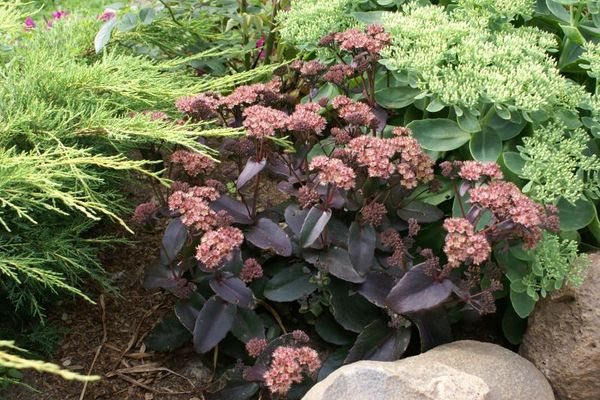

Landing
If you bought a stonecrop sapling in a store, you should immediately transfer it to normal soil. The peat mixture used in stores serves as a temporary solution; sedum will not grow in it.
If you are planning to decorate a garden in your country house with succulent, take seedlings in late spring or early autumn. For home maintenance, planting in the ground is carried out in the spring..
When planting in open ground, make a distance of 20 cm between the seedlings. Slightly deepening the root system, sprinkle it with earth and water it abundantly. Planting and caring for hernial grass does not require serious gardening skills, so it is advised for beginners to decorate cozy corners of the garden.
Soil composition
The main thing in the condition of the soil is its looseness and good moisture and oxygen permeability.
If you yourself prepare the soil for hare cabbage, take leafy and sod land in equal shares, add half of the river sand to them, mix everything. Subsequently, when the plant hardens and begins to grow actively, be sure to regularly loosen the soil.
Top dressing
The frequency and amount of fertilizing depends on the quality of the soil. As a rule, sedum is fed at the very beginning of the growth of young shoots. For feeding, wood ash and rotted manure are used.
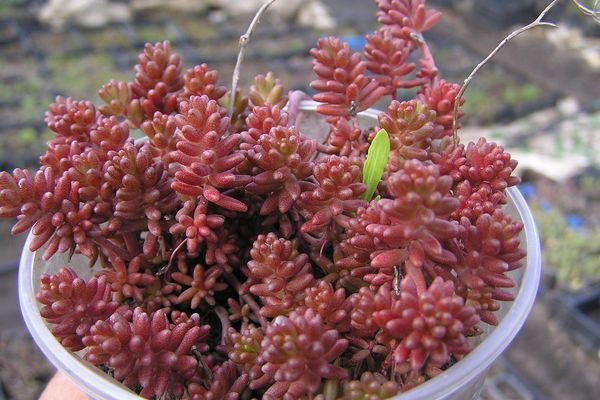

The plant needs additional nutrition at the beginning of flowering. It needs phosphorus-potash liquid fertilizers (Agricola, Good Power, Bona Forte).
Nitrogen fertilizers must be applied before sedum wintering (September-October) so that the plant can calmly survive the low temperatures when kept outdoors.
Important! It is not recommended to feed purple sedum immediately after purchase. You need to wait 1 month for the plant to acclimatize.
The need for watering
Do not forget that sedum is a succulent. Moderate watering is enough for the plant; from excess moisture, its roots rot and get sick with various fungal infections.
The regularity of watering is determined by the condition of the soil: if it is well dried, then the plant needs to be watered. The best time to water is evening.... On hot summer days, stonecrop needs additional portions of moisture. In winter, one watering every 2 weeks is enough for hare cabbage.
Bloom
The first purple flowers bloom on the plant in mid to late July and are pleasing to the eye for 2-3 months. They have a pleasant, rich aroma that attracts bees. The sedum is considered a melliferous plant.
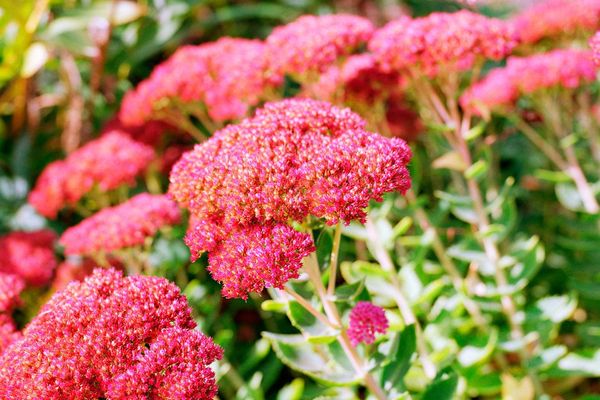

Period of life
Sedum purple refers to perennial plants. The lifespan of new shoots is 2 years, during which they have time to grow, bloom and give seeds.
Attention! In order for sedum to decorate your garden or balcony for a long time, it is necessary to rejuvenate the succulent growth by transplanting every 5 years.
Lighting
Hare cabbage is not afraid of the sun and feels comfortable in the brightest light. Moreover: if it receives little light, then its leaves and flowers turn pale, lose their color saturation and look dull.
Lack of lighting causes sedum shoots to stretch upward, which spoils the decorative value of the flower.
Air humidity
Succulents can easily tolerate a lack of moisture, so purple sedum will not give you the trouble of finding a place with good humidity.
It also does not need additional moisture if it grows in open ground. When kept at home, spraying is used only as a hygienic procedure..
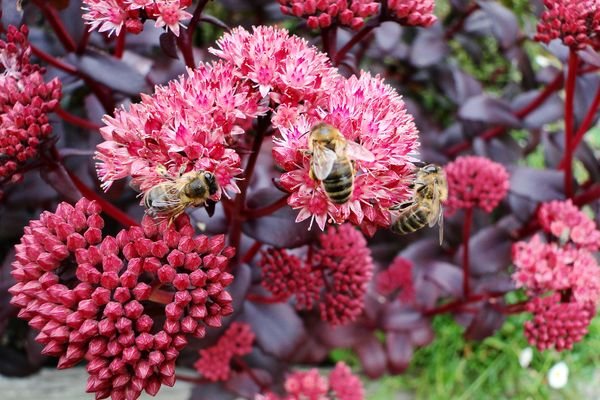

Temperature parameters
Sedum has long been adapted to the climate of Russia and grows successfully in many of its regions. He easily tolerates hot summers and cold winters.
In home content, he feels good at 22 ... 30 ° C... In winter, it is advisable to keep the flower at a temperature not exceeding 15 ° C.
Attention! With an increase in the standard air temperature in winter, sedum loses its decorative appearance.
Growing problems?
Usually sedum, and all its types grow, without causing trouble for flower growers. With good immunity, they can only get sick under conditions that are not suitable for them.
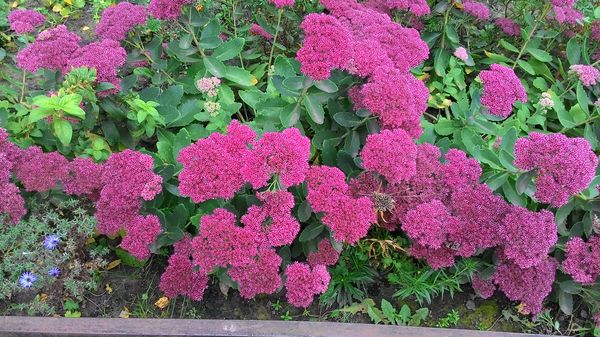

photo of the author
- If the sedum has spots on the leaves ...
Without exception, all species do not like wetlands. Excessive moisture reduces disease resistance. If the soil does not have time to dry out between waterings, or the summer is rainy, sedum can be affected by a fungus, which is manifested by spots and bloom on the leaves, curvature of the tops of the shoots and deformation of the leaf plate. Diseases of garden flowers. If the soil in your area is heavy, clayey, you must prudently choose the most sunny place, and also create a small hill so that water does not accumulate at the roots.
In addition, high humidity provokes an influx of snails and slugs, which will gladly feast on juicy leaves. Pests of garden flowers.
- If the sedum loses its color ...
The reason for the pallor of the leaves may be a lack of light, as well as an excess of salts in the soil. Species with variegated leaves especially need sunlight. Without the sun, the foliage becomes monotonous green, flowering is scarce, and the shoots are stretched out. Frequent feeding can also weaken the flower, which prefers to grow in poor soils.
- If sedum does not bloom ...
The lack of flowering in garden representatives is rare. This is possible when growing sedum from seeds. In this case, young plants form peduncles for 3 years of life, increasing the root mass. Unwillingness to bloom in adult specimens can also be caused by a lack of light, if the wrong place for planting is chosen. For example, on the shady side of a house, or under the canopy of a large tree, a sedum deprived of light can waste energy on growth, to the detriment of flowering.
The "neighbors" in the flowerbed can influence the decorativeness of the plant. So, if "gluttonous" phlox or roses grow nearby, it is necessary to fertilize the flower, since the soil around it is quickly depleted.
Sedum planting and caring for which are described in the article will become a real decoration of the flower bed and will delight from year to year.
Support our site, share the link on social networks. Thank you!
Those who have been in the hilly areas of the foothills of the Urals, in the Carpathians, in Siberia, probably saw this plant on the rocky hills. Its other name is stone rose. And, indeed, the leaves, pale green and fleshy, form a rosette of malachite color, arranged in a circle. The leaves are slightly pubescent, and in cloudy weather, or in the morning, dew settles on them. The tip of the leaf with a needle. This plant is also called rejuvenated.
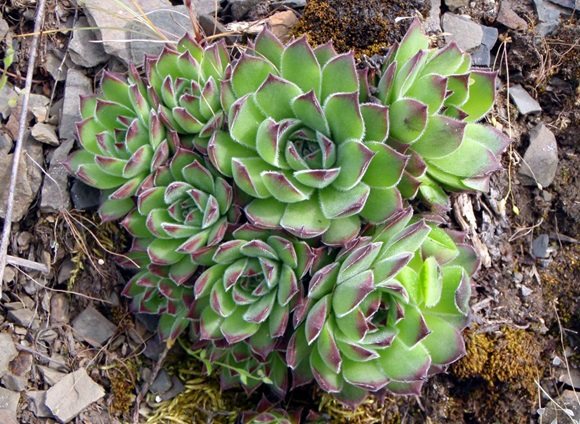

Hare cabbage belongs to the bastard family. It grows mainly on the hills blown by all winds, warmed by the hot sun. Not afraid of drought, frost or winds. Small heads of cabbage grow from early spring, when their habitats are cleared of snow and the sun begins to warm up. Gradually increasing in size, the young grows with new leaves from the middle. And the old leaves on the edge gradually die off and dry up. Hare kale reproduces in two ways - vegetatively, and with the help of seeds.
The vegetative propagation method for this plant is very interesting. In the axils, the plant forms new heads of cabbage, which, increasing in size, are connected with the mother plant by a thread - an air root. When the head of cabbage grows back and its thread reaches the ground, it will give roots, take root and become independent. That is why hare cabbage always grows in colonies. In the middle of summer, in the most developed, formed plants, a peduncle appears - from the middle, a stem begins to grow, covered with fleshy leaves, at the top of which there are flowers. Seeds that have ripened in a flower have little chance of taking root - after all, everything around is already occupied by the sisters.But sometimes they get lucky. So the plant has developed its own survival tactics for centuries - not by seeds, but by shoots, but still lives and lives.
Reproduction
Breeding methods for hare cabbage are no different from those that we apply to any plants. If you want a purple carpet to decorate your site, use bush division, cuttings, or use seed growing.
By cuttings
Cuttings are taken from an adult plant (you can do this during pruning). There are two methods for rooting cuttings. In the first case, the cut stems of the squeaky grass are dipped into a bowl of water and wait for the roots to appear.
In the second method, the cuttings are rooted in wet sand: a container is selected, filled with sand, watered and the cuttings are inserted. It will take 1.5-2 weeks for rooting.... The main thing is to make sure that the sand is always wet.
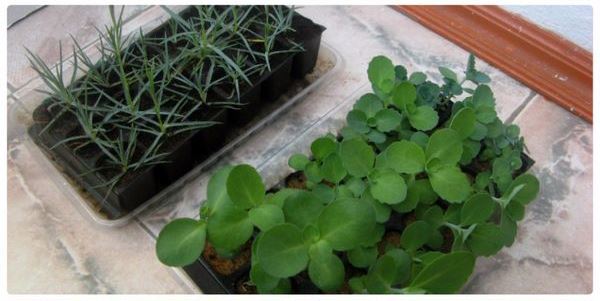

Seeds
When stonecrop purple seeds multiply, they can be planted immediately in open ground or previously obtained seedlings and then transferred to a permanent place of residence.
Sowing lasts from late April to early May... For better germination and development of the plant, ash, sand, peat and sawdust should be added to the soil.
Before introducing seeds into the soil, it must be watered well. After spreading the seeds, they are covered with foil or glass. If the second method is used, then the seedlings are transferred under the open sky when the sprouts give 2-3 leaves.
Please note that sedum grown from seeds will bloom only in the second or third year of life.
By dividing the bush
They resort to dividing the bush when the adult plant is 4–5 years old. The transplant is carried out in the spring. They dig up the plant, shake the earth from the roots, carefully divide it into several parts.
Then the separated parts must be dried for 3-4 days. Then they are planted in holes made in advance at the location of the plant.
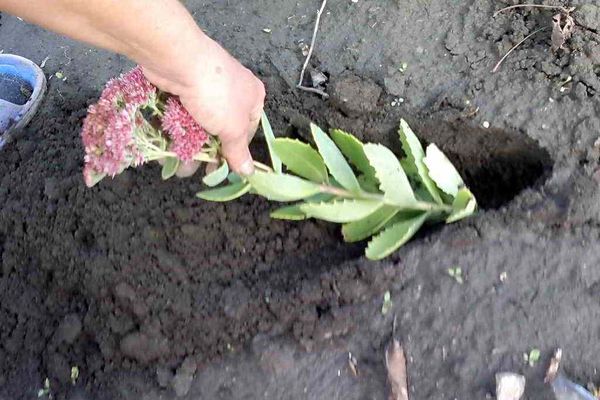

Medicinal properties and contraindications
The plant has a wide range of applications. If you know the properties of stonecrop, then you can fight many ailments. The healing qualities of the plant:
- Hemostatic and analgesic, relieves inflammation and heals wounds;
- Strengthens the nervous system;
- Tannins strengthen the walls of blood vessels, reducing the formation of blood clots, lowering the pressure;
- In case of colds, it has a beneficial effect on the upper respiratory tract, promoting the discharge of phlegm and destroying pathogenic microbes;
- Improves the functioning of the gastrointestinal tract, stimulates bile formation with the help of flavonoids;
- Improves metabolism, helps to stabilize weight, removes toxins;
- Coumarins in the plant inhibit and suppress cancer cells, stopping metastases.
Related article: British elecampane - useful properties, description
The use of stonecrop is very extensive. Infusions and lotions treat wounds and inflammations on the skin. The oil mixture is used for eczema and neurodermatitis, lichen. Pounded leaves eliminate boils and abscesses, relieve joint pain. Periodontal disease, stomatitis and inflammation of the gums can be eliminated by rinsing the mouth with infusion or decoction of stonecrop.
It is used to treat and prevent diseases of the gallbladder, adrenal glands, and liver. The sedum cleans the body of parasites, helps to alleviate cough in tuberculosis, bronchitis, relieves itching and swelling with insect bites.
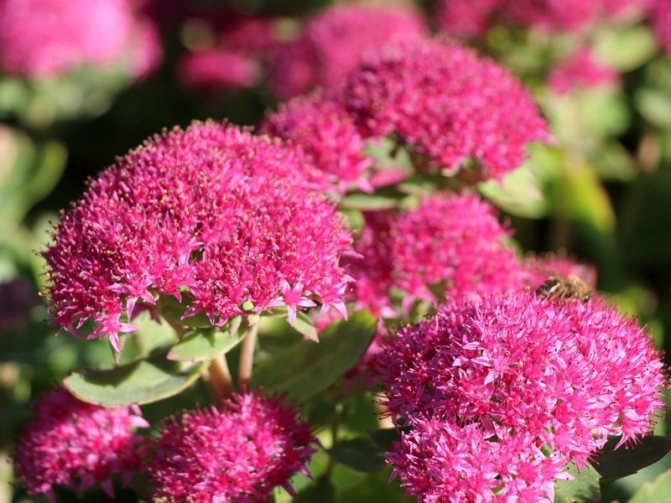

Official medicine uses raw materials in the treatment of eyes: burns of the mucous membrane of the eye, opacity of the cornea. The plant is used in surgery for bone tissue fusion, trophic ulcers of the leg. In cardiology, sedum is used to increase the tone of the heart muscle, stimulate the heart. The sedum is found in many biostimulants. He successfully fights freckles, papillomas, warts in cosmetology. You can wipe freckles with the juice of the flowers of the plant, after a while they become less noticeable.
In addition to medicinal properties, stonecrop has contraindications... It is harmful to children, pregnant women, breastfeeding mothers. Excessive use can cause vomiting, dizziness, and general malaise. The plant extract should be taken internally with discretion and preferably under the supervision of a competent specialist.
Plant composition
Nature has invested many useful substances in sedum, its medicinal properties are extensive. Tannins help relieve inflammation, heal wounds faster, normalize the work of the gastrointestinal tract, remove unwanted actions of microbes and bacteria.
Ascorbic acid removes toxins, enhances the absorption of iron, improves the functioning of the central nervous system, and raises immunity.
Glycosides help vasodilation, sputum discharge, and enhance the diuretic effect. Alkaloids lower blood pressure, act as a pain reliever. Carbohydrates energize the entire body.
Organic acids reduce blood cholesterol, have a beneficial effect on the intestines, normalize metabolism, renew joint mobility, stimulate insulin production, have a beneficial effect on blood vessels, and increase reproductive activity.
Flavonoids stimulate adrenal function, normalize heart rate, promote bile formation, and reduce vascular permeability.
Saponins prevent plaque formation, remove phlegm, act as a diuretic, and heal wounds and ulcers. Coumarins stop the development of tumors, preventing metastases from growing.
Diseases and pests
A common stonecrop disease is root rot... The plant signals it by yellowing and falling leaves. The cause of the disease is strong soil moisture.
To eliminate the problem, the flower is selected from the soil, the decayed roots are separated, the remaining ones are treated with a solution of potassium permanganate, the plant is transferred to a new place or pot.
Occasionally sedum is attacked by spider mites or aphids... Having noticed a pest, you need to treat hare cabbage with soap and soap-alcohol solution. If time is lost and the lesions are profuse, insecticides are used (Bona Forte, Good Power, Agricola).
To fight slugs, they also resort to using chemicals ("EcoKiller", Ferramol). In addition, the soil under the plant should be sprinkled with a layer of wood ash or sand 2-3 cm high.
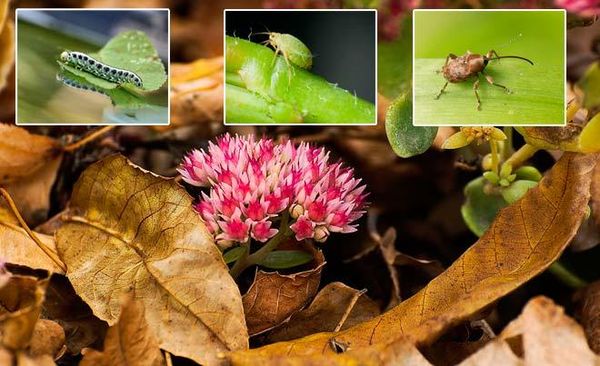

Useful properties of rabbit cabbage
As a medicinal plant, sedum purple has high biostimulating properties.
By accumulating organic acids, the plant helps to improve metabolic processes, enhances cell regeneration, and has an anti-inflammatory effect. The healing properties of rejuvenated allow:
- Improve the healing of wounds and burns. Making lotions from the leaves of grass, you can cope with calluses, reduce warts.
- Reduce pain in joint diseases.
- Strengthen the gums for periodontal disease. The sap of the plant is used to massage diseased gums.
In ophthalmology, purpurea is used in the treatment of diseases such as traumatic iridocyclitis, corneal opacities, with corneal burns... An aqueous extract of hare cabbage is prescribed for recovery from severe blood loss and severe trauma.
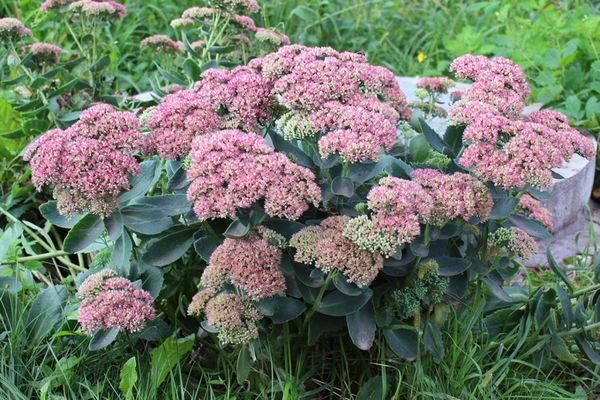

Sedum under a microscope
So what exactly is sedum useful for? The composition contains vitamin C, as well as B vitamins, tannins. Thanks to this, wounds heal faster, skin cells, membranes become more elastic. The life cycle of the cell increases.
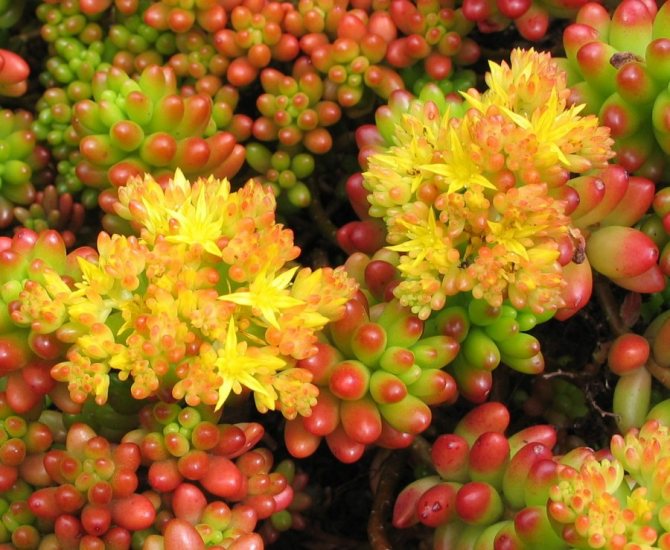

The antioxidant carotene, which is also in the plant, enters the body along with a decoction, tea, cream, and rejuvenates cells. Organic acids maintain the acid-base balance. Glycosides and alkaloids have a stimulating effect.
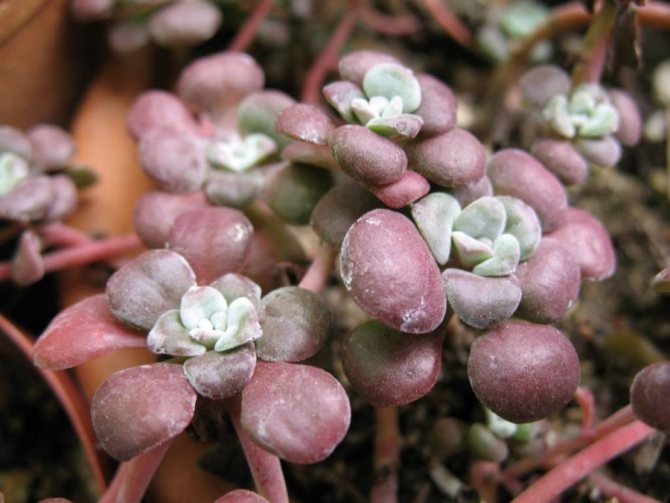

What type of stonecrop is better to choose? Most of them belong to medicinal plants. But not all are beautiful enough to choose them for a bedroom, hall, kitchen.Some are better to plant outside the window, admire the flowers on a cloudy autumn morning, and green foliage in winter.
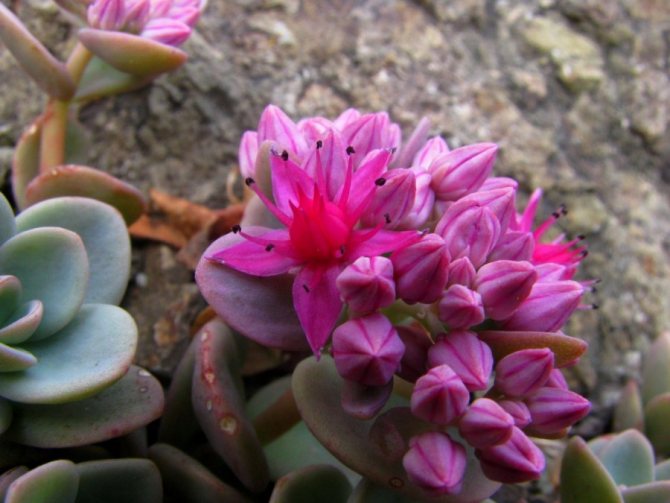

The sedum plant itself is perhaps not a competitor to indoor flowers. You need to connect your imagination, use stones, large areas of land, a mosaic of shells, lawn grass and so on.
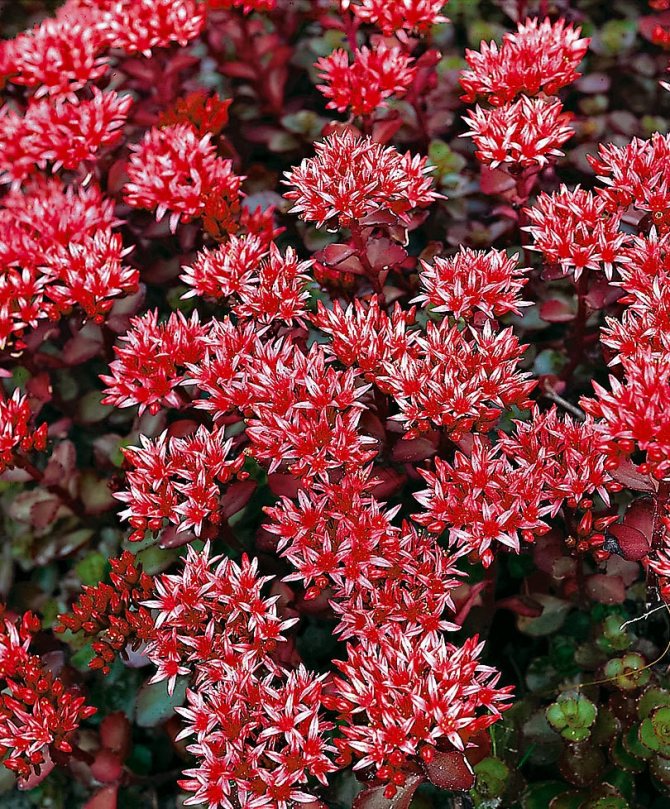

It is indifferent to moisture, it can be placed next to a miniature fountain, for example. Some species like the sun, others like shade. Lighting needs to be given a lot of attention, which is both easy and difficult at the same time.
A garden is an optimal combination of completely different plants. They should not interfere with each other. If one flower loves light, it should be placed under a special flower lamp more often.
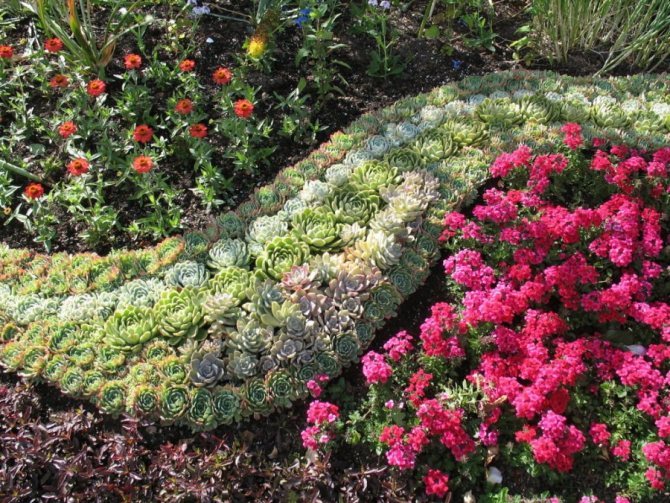

It is not advisable to plant nearby plants that do not like light. Maintaining the natural harmony of photosynthesis will have to spend more time than necessary.
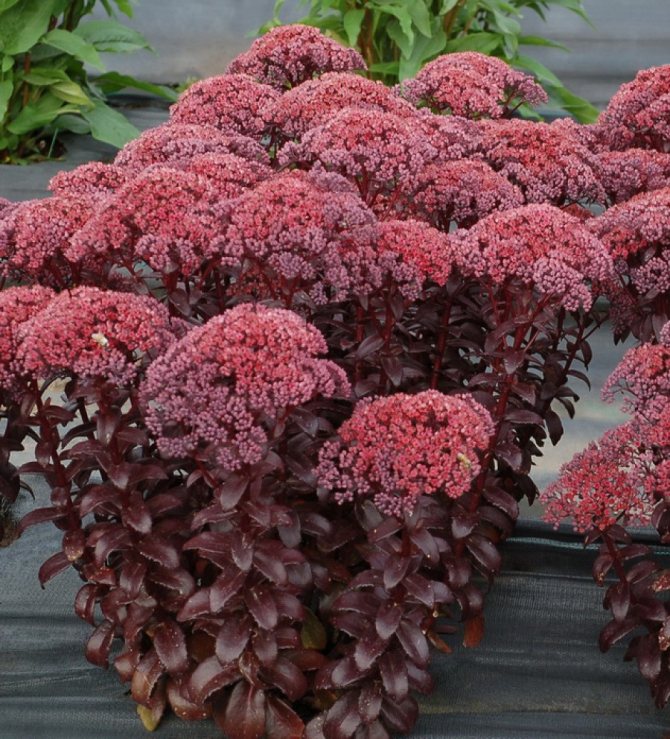

Taking care of one plant is easy to damage the neighboring one. It is necessary to combine them correctly, harmoniously. In this case, aesthetic pleasure from contemplation will be received.
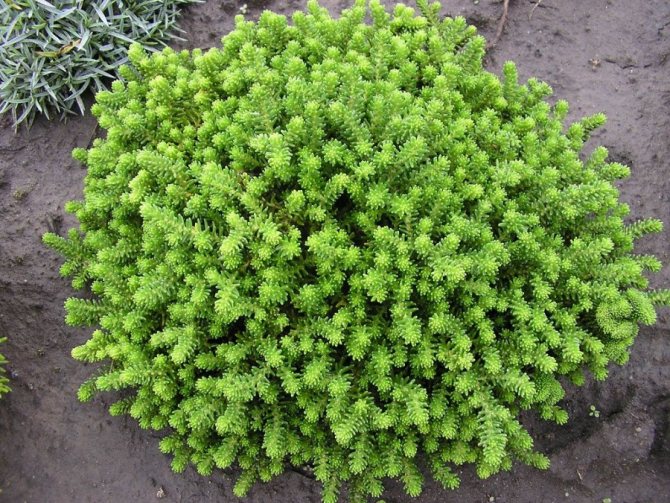

Application in traditional medicine
The fact that sedum is rich in healing substances and is able to help with many diseases has long been known in folk medicine.
Medicinal properties of the plant used to fight skin diseases, treat gums, recover from fractures, relieve colds.
Here are some recipes for traditional medicine:
- To normalize blood pressure... Take any part of the hare cabbage (except for the roots), pour 200 ml of boiling water, hold on low heat for 5 minutes. Take 1 tablespoon cooled 3 times a day.
- Against rheumatism. Grind the leaves of stonecrop. Wrap the gruel from the leaves in gauze, pour boiling water over it and attach to the diseased areas.
- Infusion of stonecrop leaves... 1 tablespoon of the plant is taken in a glass of hot water and infused for 4 hours. Take 0.1 ml 3 times a day. Helps in the treatment of malaria, constipation, fever.
- Stonecrop powder for epilepsy... Dry the leaves and stems of the plant, grind to a powder. Take a spoonful twice a day with water. The course of treatment is 2-3 months.
Varieties of cabbage
There are several types of sour cherry (another name for cabbage).
- Violet oxalis is characterized by a pleasant lilac color. The tree grows up to 1 m in height. This garden culture is often grown at home. Caring for him is timely watering (1 time per week).
- Forest oxalis has characteristics of similarity with another variety - ordinary stonecrop. The difference between them is that the forest variety can only grow in the wild (hence the name). The flower of this species is not very large.
- The red variety is more common in Siberia. The height of the bush reaches 60 cm. Flowers are presented in red or pink colors.
- Common sedum is a houseplant that can be grown at home. The best growth is observed in the wild. The height of the bush is about 70 cm. The flowers have a purple hue.
Competent procurement of raw materials
The harvesting of purple stonecrop begins during the flowering period of the plant, when all its healing qualities are enhanced at times. To collect raw materials, you need to choose a dry day and stock up on sharp scissors. Cut the shoots together with the leaves you need to be careful not to harm the remaining shoots.
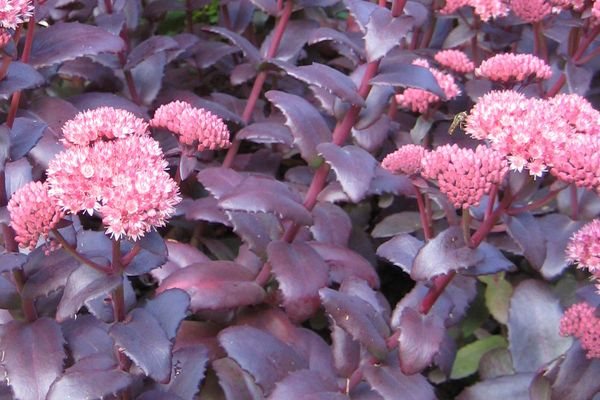

Stonecrop roots are collected in the fall, when the plant has bloomed. The roots are cleaned from the ground, washed, cut along the growth and sent to dry.
At first, it is useful to hold the raw material in the fresh air, covering it from moisture. When the roots dry out a little, they can be transferred to the room and brought to the desired condition.

